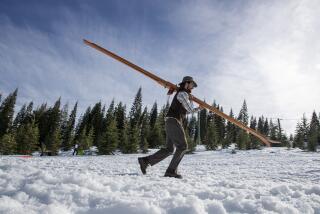Flying shovels
It looks like just another flimsy excuse to wear a shiny red bodysuit, but shovel racing requires as much skill as any sport involving human projectiles: You try steering a $69.95 wood-handled grain scoop straight off the Home Depot rack at speeds up to 72 mph.
Yet the shovel -- despite fleeting exposure at the Winter X Games and a handful of dedicated riders -- has failed to match even the underwhelming popularity of its cousin the luge. Imagine congenial Olympics frontman Bob Costas shortchanging America’s rabid figure-skating fans for shovel coverage.
Still, public interest in shovel racing perks up at this time every year when the sport’s purported birthplace, Angel Fire Resort in New Mexico, holds its annual world championships on a 1,500-foot hardpack course. Competitors may enter in three classes: production (one shovel, one rider, one hill), light modified (fabricated contraption using skis instead of shovel and not to exceed 100 pounds) and super modified (think Indy car).
Which brings us to a few logistical questions:
What gives production-class winners an edge? The ability to keep their skinny butts in the cold metal shovel bucket, maintain proper body position (feet and hands off the snow and off the handle), avoid bumps and formulate a temperature-appropriate wax. According to repeat contender and worldrecord holder John Strader, successful lubricants have included standard ski wax, car wax and Teflon coatings. And Spam.
Back to you, Bob.
For details on the 29th Annual World Shovel Race Championships, go to www.angelfireresort.com/winter/index .php?PAGE=press_release7.


